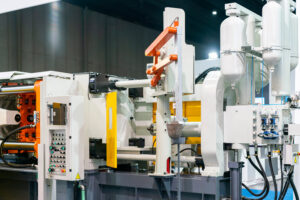Intro
If you want to quickly and affordably make a number of identical metal parts, you might consider die casting. Now you just have to decide if you want to use cold or hot chamber die casting.
As part of our die casting 101 series, this guide is all about hot chamber die casting specifically. Our manufacturing experts will explain what it is, how it works, and some major pros and cons of this method.
What Is Die Casting?
In case you don’t know, die casting is a manufacturing style that entails pushing hot, molten metal into a pre-machined cavity. The cavity fills with molten metal, cools, then becomes solid. Die casting is essentially the metal alternative to injection molding.
Within the world of die casting, there are two different types: hot chamber and cold chamber die casting. The difference revolves around the temperature of the chamber (which isn’t shocking, based on the names).
How Does Hot Chamber Die Casting Work?
In a cold chamber die casting setup, you’ll have a furnace somewhere, and a die somewhere else. The furnace is the part that gets the metal hot enough to melt, and the die is the metal tooling that has cavities that shape the molten metal into your part’s final shape. The operator will scoop metal from the furnace, then walk it over to the die and fill the cavity.
In a hot chamber die casting operation, things are a lot more streamlined. Specifically, there’s an integrated furnace that feeds directly into the die. In other words, the furnace and die are all part of one machine.
To push the metal, you’ll also have an attached nozzle and ports which facilitate the flow of metal from the furnace directly into the fixed die.

Benefits and Disadvantages of Hot Chamber Die Casting
To better understand this technology, let’s break down the benefits and disadvantages of hot chamber die casting. This should help you make your decision as you’re picking the perfect die casting operation to go with on your next project.
Benefit: Quick Production Cycle
Since the furnace feeds directly into the die, you’ll appreciate a much faster production cycle. In addition, the material choices of hot chamber die casting are limited to metals that can quickly melt and cool, resulting in even faster turnaround times.
Benefit: Longer Tool Life
With a hot chamber die casting process, you’ll find that the actual temperatures achieved are a lot lower. This seems odd, since this is the “hot” version of die casting. But, the temperatures are lower because the utilized metals have much lower melting temperatures.
With lower temperatures, your tooling will see fewer thermal stresses. The result? Longer tool lives. Since tooling can be a massive upfront cost, you want each mold to last as long as possible.
In other words, you’ll have lower long-term operating costs and lower per-unit costs when you stick to hot chamber die casting.
Disadvantage: Limited Material Choice
We keep mentioning that hot chamber die casting has a more limited selection of materials, which is actually a big disadvantage for many engineers. Since this technology requires a metal with lower melting temperatures, you’ll usually have to work with zinc and some magnesium alloys.
This, of course, takes aluminum out of the running. The problem is that aluminum has a melting temperature of 660°C, and zinc melts at just 420°C. With an attached furnace, it’s not possible to keep temperatures that high and achieve the precision that you need.
But, this isn’t a problem if you were planning on using zinc in the first place. At Rapid Axis, we always suggest using hot chamber die casting whenever zinc is your material of choice.
Disadvantage: Not for Low-Volume Production
Just like any die casting operation, hot chamber die casting is not good for low-volume production runs. Why? It’s because the upfront tooling cost is so steep that it doesn’t make financial sense unless you make hundreds or thousands of units.
With each unit you make, your per-unit cost goes down. Eventually, it becomes a really affordable way to make a ton of metal parts.
If you want a few prototypes built, you’re better off with CNC machining or DMLS 3D printing.
Conclusion
Now you know everything about hot chamber die casting. This process is faster and more affordable than the cold chamber alternative, but it only works well with zinc or magnesium. If you want to get started with a new die casting operation, reach out to our experts at Rapid Axis. We have plenty of experience in this industry and we can make high-quality die-cast parts for you. Get a free quote today.

